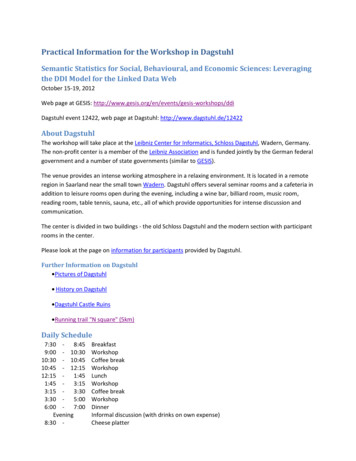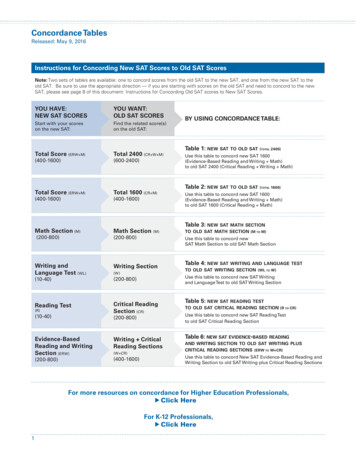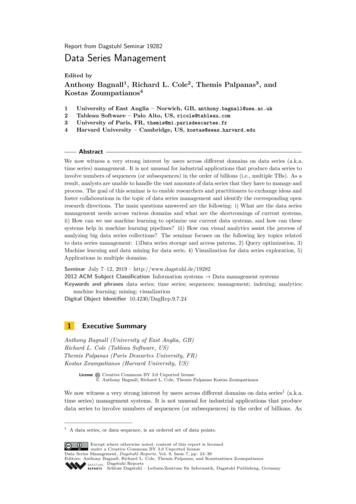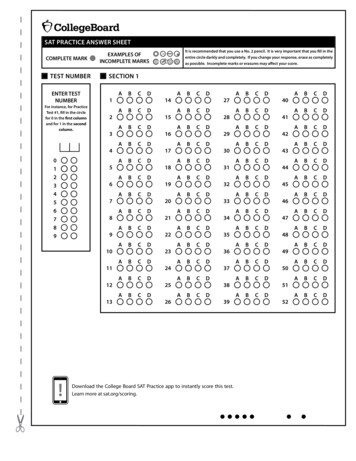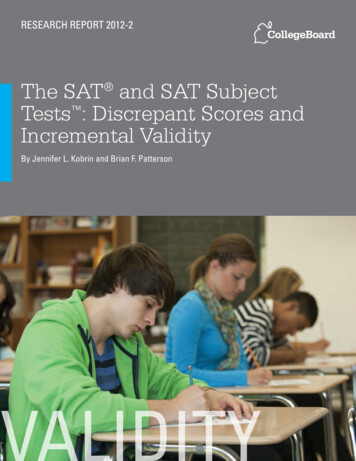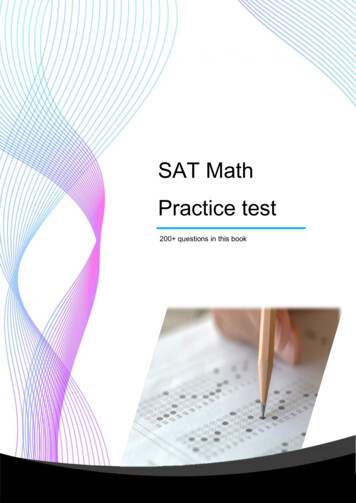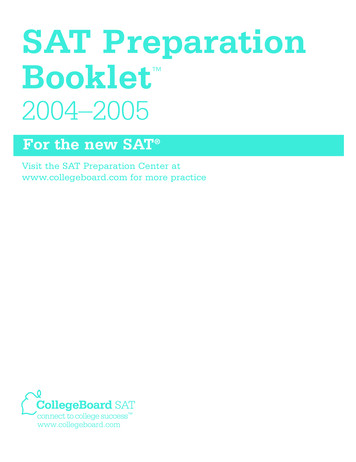
Transcription
A Linear Time Algorithm for Quantum 2-SATNiel de Beaudrap 1 and Sevag Gharibian†21Department of Computer Science, University of Oxford, Oxford, UKniel.debeaudrap@cs.ox.ac.ukDepartment of Computer Science, Virginia Commonwealth University,Richmond, USAsgharibian@vcu.edu2AbstractThe Boolean constraint satisfaction problem 3-SAT is arguably the canonical NP-complete problem. In contrast, 2-SAT can not only be decided in polynomial time, but in fact in deterministiclinear time. In 2006, Bravyi proposed a physically motivated generalization of k-SAT to thequantum setting, defining the problem “quantum k-SAT”. He showed that quantum 2-SAT isalso solvable in polynomial time on a classical computer, in particular in deterministic timeO(n4 ), assuming unit-cost arithmetic over a field extension of the rational numbers, where n isthe number of variables. In this paper, we present an algorithm for quantum 2-SAT which runsin linear time, i.e. deterministic time O(n m) for n and m the number of variables and clauses,respectively. Our approach exploits the transfer matrix techniques of Laumann et al. [QIC,2010] used in the study of phase transitions for random quantum 2-SAT, and bears similaritieswith both the linear time 2-SAT algorithms of Even, Itai, and Shamir (based on backtracking)[SICOMP, 1976] and Aspvall, Plass, and Tarjan (based on strongly connected components) [IPL,1979].1998 ACM Subject Classification F.2.1 Numerical Algorithms and ProblemsKeywords and phrases quantum 2-SAT, transfer matrix, strongly connected components, limitedbacktracking, local HamiltonianDigital Object Identifier 10.4230/LIPIcs.CCC.2016.271IntroductionBoolean constraint satisfaction problems lie at the heart of theoretical computer science.Among the most fundamental of these is k-SAT, in which one is given a formula φ on nvariables, consisting of a conjunction φ(x) C1 C2 · · · Cm of m clauses, each of which isa disjunction of k literals, e.g. (xh x̄i xj ) for 1 h, i, j n. The problem is to determinenwhether there exists an assignment x {0, 1} which simultaneously satisfies all of theconstraints Ci , i.e. for which φ(x) 1. While 3-SAT is NP-complete [6, 22, 16], 2-SATadmits a number of polynomial time algorithms (e.g. [7, 20, 10, 2, 23]), the fastest of whichrequire just linear time [10, 2].In 2006, Bravyi [3] introduced k-QSAT, a problem which generalizes k-SAT, as follows.In place of clauses Ci , acting on k-bit substrings of n bit strings x {0, 1}n , one considers †Supported by Centrum Wiskunde & Informatica, European Commission FET-Proactive project QuantumAlgorithms (QALGO) 600700, and the UK Quantum Technology Hub project NQIT.Supported by a Government of Canada NSERC Banting Postdoctoral Fellowship, the Simons Institutefor the Theory of Computing at UC Berkeley, and NSF grant CCF-1526189. This project was initiatedwhile SG was visiting Ronald de Wolf and Centrum Wiskunde & Informatica, whom SG thanks fortheir hospitality. Niel de Beaudrap and Sevag Gharibian;licensed under Creative Commons License CC-BY31st Conference on Computational Complexity (CCC 2016).Editor: Ran Raz; Article No. 27; pp. 27:1–27:21Leibniz International Proceedings in InformaticsSchloss Dagstuhl – Leibniz-Zentrum für Informatik, Dagstuhl Publishing, Germany
27:2A Linear Time Algorithm for Quantum 2-SATorthogonal projectors Π̄i which act on k-qubit subsystems of an n-qubit system ψi H n ,where H : C2 . (A sketch of how k-SAT can be embedded into k-QSAT is given in Section 2.)These projectors extend to act on states ψi by defining Πi Π̄i I, so that Πi acts asthe identity on all tensor factors apart from those qubits on which Π̄i is defined. One thenconsiders ψi to “satisfy” the 2-QSAT instance if Πi ψi 0 for all i. This formulation maybe motivated, e.g., by problems in many-body physics [9, 4]. While 3-QSAT is completefor QMA1 [3, 13] (a quantum generalization1 of NP), 2-QSAT is solvable in deterministicpolynomial time [3], using O(n4 ) field operations over C.Given the existence of linear time algorithms for classical 2-SAT, this raises the naturalquestion: Can 2-QSAT also be solved in linear time? Our main result in this paper is asfollows.I Theorem 1.1. There exists a deterministic algorithm SOLVEQ which, given an instanceof 2-QSAT, outputs a representation of a satisfying assignment if one exists (presented as alist of one- and two-qubit unit vectors to be taken as a tensor product), and rejects otherwise.SOLVEQ halts in time O(n m) on inputs on n qubits with m projectors (assumingunit-cost operations over C).Furthermore, SOLVEQ can produce its output using O((n m)M (n)) bit operations,where M (n) is the asymptotic upper bound on the cost of multiplying two n bit numbers;If the projectors are all product projectors, the algorithm SOLVEQ requires only O(n m)bit operations regardless of what computable subfield F C the projector coefficients rangeover.In particular, the setting of product constraints above includes classical 2-SAT: in this casethe bit-complexity of our algorithm matches optimal 2-SAT algorithms [10, 2].I Remark. For general instances of 2-QSAT, the O((m n)M (n)) bit-complexity of ouralgorithm compares favourably with the complexity of extracting a satisfying assignmentusing Bravyi’s 2-QSAT algorithm, which requires O(n4 M (n)) bit operations if one usessimilar algebraic algorithms to ours. In “Significance and open questions” below, we discussthe question of field-operation-complexity vs. bit-complexity, as well as whether our algorithmis tight in terms of bit complexity.Techniques employedThe origin of this work is the observation that Bravyi’s 2-QSAT algorithm can be thoughtof as an analogue of Krom’s 2-SAT algorithm [20], which involves computing the transitiveclosure of directed graphs. Krom’s algorithm repeatedly applies a fixed inference rule foreach pair of clauses sharing a variable. The repeated application of the inference rule leadsto an O(n3 ) time to determine satisfiability and an O(n4 ) time to compute a satisfyingassignment. Bravyi’s algorithm has the same runtimes, measured in terms of the number offield operations.This work aims to develop a quantum analogue of Aspvall, Plass, and Tarjan’s (APT)linear time 2-SAT algorithm [2], which reduces 2-SAT to computing the strongly connectedcomponents of a directed graph. Note that classically (α β) is equivalent to (ᾱ β) and(β̄ α), for literals α and β. APT constructs an implication graph G of a 2-SAT instance1Here, Quantum Merlin Arthur (QMA) is the quantum analogue of Merlin-Arthur (MA) in which theproof and verifier are quantum, and QMA1 is QMA with perfect completeness. Unlike the classicalsetting, in which MA is known to admit perfect completeness [27, 12], whether QMA QMA1 remainsopen (see e.g. [15]).
N. de Beaudrap and S. Gharibian27:3φ, with vertices labelled by literals xi and x̄i for each i, and edges ᾱ β and β̄ α foreach clause (α β). Then, they show that φ is satisfiable if and only if xi and x̄i are notin the same strongly connected component of G for any i [2]. As the strongly connectedcomponents of G can be computed in linear time [25], this yields a linear time algorithm for2-SAT.In the quantum setting, not all n-qubit states can be described by assignments toindividual qubits (e.g., entangled states). Fortunately, Chen et al. [4] show that we mayreduce any instance of 2-QSAT to an instance which is satisfiable if and only if there is asatisfying state, in which qubits have separate assignments (see Section 2 for details). Inthis setting, there is a natural analogue of the equivalence (xi xj ) (x̄i xj ) (x̄j xi )in terms of so-called “transfer matrices” (e.g. [3, 21]). For any rank-1 quantum constraint Πij L C2 C2 on qubits i and j, there exists a transfer matrix Tij L C2 , suchthat for any assignment ψi i to qubit i such that Tij ψi i 6 0, the state on qubit j for which the constraint Πij is satisfied is given by Tij ψi i.2 (Conversely,for any Tij L C2 , there is a unique rank-1 orthogonal projector Πij L C2 C2 whose nullspace is spannedby ψi i Tij ψi i for ψi i ranging over C2 .) This suggests a quantum analogue G of animplication graph: For each possible assignment ψi to a qubit i, we define a vertex (i, ψi),and include a directed edge (i, ψi) (j, φi) if there is a transfer matrix Tij (correspondingto some constraint Πij ) such that Tij ψi c φi for some c 6 0. We then ask if for eachqubit i, there is a vertex (i, ψi i) which cannot reach any (i, ψi0 )i where ψi i 6 ψi0 i. If thereare such paths (i, ψi i) · · · (i, ψi0 )i for all ψi i, this is analogous to xi and x̄i being in acommon strong component in the APT algorithm.As it stands, this approach has a shortcoming: In the quantum regime, each qubit has acontinuum of possible assignments (rather than two), which may generate unbounded orbitsin an APT-style algorithm. However, by applying techniques of Laumann et al. [21] fromthe study of phase transitions in random 2-QSAT, we may in some cases reduce the set ofpossible assignments for a qubit i to one or two. Consider the interaction graph G0 of a2-QSAT instance, in which vertices correspond to qubits, and two vertices are connectedby an (undirected) edge if the corresponding qubits i and j are subject to a constraint Πij .Suppose C (v1 , . . . , vt , v1 ) is a cycle in G0 , with transfer matrices Tvi vi 1 arising from eachconstraint Πvi vi 1 , and compute TC : Tvt v1 · · · Tv2 v3 Tv1 v2 . If TC has a non-degeneratespectrum, then the only possible satisfying assignments for v1 are eigenvectors of TC [21](see also Lemma 2.2). In effect, computing TC “simulates” uncountably many (!) traversals(i, αi) · · · (i, βi) in G; restricting to the eigenvectors of TC corresponds to ignoringvertices in G which are infinitely far from the top of any topological order of G. If we hencedescribe cycles C with non-degenerate TC as discretizing, this suggests the approach offinding a discretizing cycle at each qubit i, and using it to reduce the number of possiblestates on i to one or two. This simple principle is the starting point of our work.Despite this simplicity, some obstacles must be addressed to obtain a linear-time algorithm.In the setting of random 2-QSAT [21], every cycle C is a discretising cycle with probabilityone, as there is zero probability that either a transfer matrix is singular, or that a product ofthem has a degenerate spectrum. This allows one to quickly reduce the space of assignmentspossible for a qubit. In contrast, in our setting (i.e., worst case analysis), we cannot assume2The usual convention is to describe quantum states by unit vectors in C2 , albeit up to equivalenceunder multiplication by z C for z 1. However, vectors produced via transfer matrices might notbe normalised. As we are not explicitly concerned with the probabilities of any measurement outcomesobtained from quantum processes, we represent quantum states by vectors which are equivalent up tomultiplication by arbitrary (non-zero) scalar factors.CCC 2016
27:4A Linear Time Algorithm for Quantum 2-SATsuch a distribution of transfer matrices arising from a 2-QSAT instance. For instance, anyconstraint Πij corresponding to a product operator (e.g., a classical 2-SAT constraint) hasa singular transfer matrix, which when multiplied with other singular matrices may giverise to a singular cycle matrix. Even if a discretising cycle C does exist using some of theedges jk, k , . . . , we may have to traverse those edges multiple times to discover C, which isworrisome for a linear-time algorithm. Furthermore, we must address the case in which thereare no discretising cycles at all to get a discrete algorithm started. In order to demonstrate alinear-time algorithm for 2-QSAT in the spirit of APT, these problems must be carefullyaddressed.Our approach to resolve these issues is as follows. In an instance of 2-QSAT in whichall transfer matrices are non-singular, we show that discretising cycles are easy to find ifthey exist, and that the absence of discretising cycles allows one to easily obtain a satisfyingstate. If, on the other hand, singular transfer matrices are present, the corresponding productconstraints Πij αihα i βihβ j themselves impose a different discretising influence: If α i and β i are states orthogonal to αi and βi respectively, then at least one of theassignments (i, α i) or (j, β i) is required for a satisfying assignment. This leads us toadopt an approach of “trial assignments” which is highly reminiscent of another linear-time2-SAT algorithm due to Even-Itai-Shamir [10], which attempts to reduce to an instanceof 2-QSAT with fewer product constraints by determining partial assignments satisfyingΠij . (For simplicity, we also adopt the approach of trial assignments for qubits whose statespace have been reduced by discretizing cycles.) This leads us to our algorithm SOLVEQ(Figure 1, in Section 4), which combines elements of both the Even-Itai-Shamir [10] andApsvall-Plass-Tarjan [2] linear-time 2-SAT algorithms as described above.Our approach can be summarised as follows. Following Chen et al. [4], we first preprocessour input instance Π and either determine that Π is unsatisfiable, or obtain a new 2-QSATinstance Π0 which is satisfiable by a product state if Π is satisfiable at all. From this pointon, our algorithm uses the central notion of a chain reaction (CR) (see Section 3): thisroughly models the idea that given an assignment ψi i to qubit i, following a sequenceof transfer operators according to the implication graph of Π0 deterministically results inassignments to a subset of other qubits in the instance. In particular, what we are interestedin is finding conflict-free CRs, which are CRs that terminate without reassigning a value toa qubit j which conflicts with a previous assignment for j. To exploit conflict-free CRs, wefirst show a Set-and-Forget Theorem (Theorem 3.6), which essentially says the following:if Π0 is satisfiable, then any choice of assignments to a subset S which is prescribed by aconflict-free CR, is also consistent with a global satisfying assignment. Thus, given such aconflict-free CR, we can remove the qubits in S and all constraints acting on it from Π0 ,reducing to a smaller 2-QSAT instance Π00 which is satisfiable if and only if Π0 is. Hence,the problem of deciding Π is reduced to the task of repeatedly finding conflict-free CRs. Toshow that the discovery of conflict-free CRs may be done in linear time, we use three keyideas. First, for any product constraint in the graph, there are two associated CRs C1 andC2 ; we show that at least one of these must be conflict-free, or Π is not satisfiable. Second,once all product constraints have been exhausted, our next source of conflict-free CRs is thenotion of discretizing cycles. In general, it is not true that running a depth-first search in theconstraint graph of Π00 will yield a discretizing cycle, even if such a cycle exists! However,we show that if all constraints are entangled, then a single depth-first search (per connectedcomponent of the interaction graph) indeed suffices to find the discretizing cycle. Third andfinally, if no discretizing cycles exist in Π00 , then we show that it is easy to find a conflict-freeCR. The resulting algorithm, SOLVEQ , is presented in Figure 1.
N. de Beaudrap and S. Gharibian27:5Previous workThere is a long history of polynomial time solutions for classical 2-SAT [24, 7, 20, 10, 2, 23],ranging from time O(n4 ) to O(n m). As we mention above, the most relevant of these toour setting are the algorithms of Even, Itai, and Shamir [10] (based on limited backtracking)and Aspvall, Plass, Tarjan [2] (based on strongly connected component detection).In contrast, little work has been performed in the quantum setting. Until recently, Bravyi’salgorithm was the only explicitly articulated algorithm for 2-QSAT, and requires O(n4 ) fieldoperations and O(n4 M (n)) bit operations. Other work on 2-QSAT instead concerns eitherthe structure of the solution space of instances of 2-QSAT [21, 9, 4], or bounds on countingcomplexity [14, 8].Propagation of assignments using transfer matrices is present already in Bravyi [3], andthe results of Laumann et al. [21] allow us to restrict the possibly satisfying states on singlequbits by finding discretising cycles. We incorporate these into efficient discrete algorithmsfor testing possible assignments, and provide a cost analysis in terms of field operations andbit operations. In contrast to the random 2-QSAT setting of [21], we do not assume anyparticular distribution on constraints.Note: Very recently, Arad et al. [1] independently and concurrently presented an algorithmfor 2-QSAT, which also runs in O(n m) time using unit-cost field operations. The overallstructure of our algorithm appears similar to theirs, though our treatment of the key issue of2-QSAT instances with only entangled constraints appears to use different techniques (inparticular, Ref. [1] appears to be based on results of Ji, Wei, Zeng [14] which modify theinstance itself, whereas we use ideas of [21] to tackle the existing instance via the conceptof discretizing cycles). As well as obtaining an upper bound on field operations matchingRef. [1], we also include an analysis of the bit complexity of our algorithm SOLVEQ , and inparticular indicate how our algorithm matches the asymptotic bit complexity of the bestalgorithms on classical instances of 2-SAT.Significance and open questionsFrom a complexity theoretic perspective, just as k-SAT and MAX-k-SAT are canonicalNP-complete problems, Quantum k-SAT and its optimization variant, k-LOCAL HAMILTONIAN [19], are canonical QMA1 - and QMA-complete problems for k 3 and k 2respectively [3, 13, 19, 17], thus making their study central to quantum complexity theory.From a many-body physics perspective, quantum k-SAT deals with the study of ground statesof frustration-free local Hamiltonian systems. Such systems include Kitaev’s well-knownToric code Hamiltonian [18] (which is 4-local), whose ground space encodes logical qubits ofa topological quantum error correcting code. Our work can hence be viewed as aiming tounderstand which classical techniques for k-SAT can be generalized to explore the groundspaces of such frustration-free systems.Bit complexity. We now discuss the number of field operations used by our algorithm,O(m n), versus the number of bit operations, O((m n)M (n)), in Theorem 1.1. There isno such distinction in the complexity of existing 2-SAT algorithms: As bits have only a finiterange of values, traversing a chain of implications in the implication graph poses no precisionissues. In the quantum setting, however, such a traversal involves computing products of O(n)transfer matrices over some field extension of the rationals. Trial assignments resulting fromthese products may require O(n) bits per entry to represent; testing whether two possibleassignments are equivalent may involve multiplying pairs of n-bit integers. This is the sourceCCC 2016
27:6A Linear Time Algorithm for Quantum 2-SATof the M (n) term in the bit complexity estimate of Theorem 1.1. To compare, similarconsiderations applied to Bravyi’s 2-QSAT algorithm gives an upper bound of O(n4 M (n))bit operations.It is not obvious that a faster runtime in terms of bit complexity should be possible ingeneral. As we show in Section 6, it is simple to construct a 2-QSAT instance with m O(n)and whose unique product state solution requires Θ(n2 ) bits to write down. Thus, amongalgorithms which explicitly output the entire solution, our algorithm is optimal up to loge 2 ) for M (n) O(n log(n) 2O(log (n)) ) [11]. Furthermore,factors, taking time O(nM (n)) O(nas we also show in Section 6, for any algorithm A for 2-QSAT which produces the marginal ofa satisfying solution (if one exists) on a single qubit in reduced terms3 , there is a linear-timereduction from multiplication of n bit integers to the problem solved by A. It follows thatsuch an algorithm A must run in time Ω(M (n)). As discussed in Section 6, this implies thatunless M (n) O(n), there is no general algorithm for 2-QSAT with linear bit complexity ifthe output is required to be in reduced form.Linear bit complexity. Theorem 1.1 gives a setting in which our algorithm does have linearbit complexity – when all constraints are product operators. This special case still hasessentially quantum features, such as satisfiable instances requiring two-qubit entanglement(which our algorithm treats using techniques described in Section 2), and phase-transitionsfor satisfiability and counting complexity in randomly sampled instances which match thoseof 2-QSAT rather than classical 2-SAT [8]. It also includes the classical 2-SAT instances, forwhich our algorithm has optimal bit-complexity.Open questions. Our algorithm uses results of Chen et al. [4], which shows that anysatisfiable instance of 2-QSAT has a solution which is “almost” a product state (our algorithmfinds such solutions). In the degenerate case, however, there may also exist satisfying stateswith long-range entanglement, which may also be of interest to find. As our aim here is tostudy the optimal computational complexity of 2-QSAT, as opposed to seeking particulartypes of solutions, we leave this as an open question. We also ask: Is the bit-complexity ofO((n m)M (n)) for producing explicit assignments optimal? Is there an O(M (n)) upperbound for producing representations of marginals of satisfying assignments?Organization of this paperIn Section 2, we give notation, definitions, and the basic framework for our analysis (includingtransfer matrices). Section 3 presents a series of lemmas and theorems to demonstrate how toovercome the obstacles presented in this introduction, and which form the basis of a proof ofcorrectness for our algorithm SOLVEQ . Section 4 states SOLVEQ . Section 5 sketches boundson the runtime of SOLVEQ in terms of the field operations and bit operations. Additionaltechnical details are deferred to the full version of this paper. Section 6 discusses lowerbounds on the bit complexity of 2-QSAT.2PreliminariesWe begin by setting notation, stating definitions, and laying down the basic framework forour algorithm, including details on transfer matrices.3N.B. Our algorithm SOLVEQ is not such an algorithm, as the output may include cancellable factors inits representation.
N. de Beaudrap and S. Gharibian27:7NotationThe notation : denotes a definition and [n] : {1, . . . , n}. The vector space of (possiblynon-normalised) single-qubit pure states is denoted H : C2 . For a string x x1 x2 · · · xn n{0, 1} , we write xi : x1 i · · · xn i. For a vector space X over C, we write L (X ) forthe set of linear operators on X . The nullspace of an operator A is denoted ker(A). Forvectors ψi and φi, we write ψi φi if vi c wi for non-zero c C; if we wish to alsoallow c 0, we write ψi φi instead. The latter two definitions extend straightforwardlyto matrices. Given ψi H, we write ψ i for the unique vector (up to scalar factors) whichis orthogonal to ψi.2.1Quantum 2-SATWe now present a formal definition of quantum k-SAT (or k-QSAT). mI Definition 2.1 (Quantum k-SAT [3]). Let n k be an integer, and {Πi }i 1 L H k bea set of k-local orthogonal projection operators (i.e., of the form I Π̄i for k-qubit projectorsΠ̄i ) with coefficients over some number field F.Decision problem. Does there exist a state ψi H n such that Πi ψi 0 for all i [m]?Search problem. Produce a description of such a state ψi if it exists.For precision reasons, we require in particular that the coefficients are drawn from anumber field (a finite-degree field extension F Q[ω]). We suppose that F is also specified as Q[x]/p, togetherpart of the input by means of a minimal polynomial p Q[x] for which F with a specification of how F embeds into C [5]. (More details are given in the full version,where the runtime of the algorithm is carefully analyzed.) In the literature for 2-QSAT, oneis usually more interested in how the structure of the placement of the projectors Πi affectsthe solution space, rather than the complexity of the specification of F or the coefficients.We therefore suppose that there is some constant K which bounds from above the size ofthe specification of F, and of the coefficients of the operators Πi .We next sketch how a 2-SAT instance φ can be embedded into 2-QSAT (cases k 2 are similar). For each clause C on boolean variables (xa , xb ), we define an operator ΠC L H 2of the form ΠC : ca ihca cb ihcb , where ca 1 if the variable xa is negated in C, andca 0 otherwise; we fix cb similarly. Then ΠC is satisfied by xa xb i H 2 if and onlyif C is satisfied by xa xb {0, 1}2 . We extend ΠC to an operator on H n by taking itstensor product with I2 L H n 2 on all tensor factors i apart from a, b [n]. Performingthis for all clauses yields an instance of 2-QSAT, {ΠC }, in which all of the projectors areproduct operators (as mentioned in Section 1), and which imposes the same constraints onstandard-basis vectors xi as the clauses C impose on x {0, 1}n . Furthermore, as each ΠCis positive semidefinite and diagonal, any ψi for which ΠC ψi 0 for all clauses C mustbe a linear combination of vectors xi which also satisfy ΠC xi 0 for all C. Thus thisinstance of 2-QSAT is satisfiable if and only if the original instance of 2-SAT is, in whichcase there is a bijection between the solution space of the 2-SAT instance and a basis for thesolution-space of the 2-QSAT instance.Finally, for a given 2-QSAT instance, we denote by G its (potentially infinite) implicationgraph (defined in Section 1), and by G0 its interaction graph, whose vertices are labelled byqubits, and with a distinct edge between vertices i, j for each projector acting on them.CCC 2016
27:8A Linear Time Algorithm for Quantum 2-SATReduction to cases satisfied by product statesWe mainly consider product-state solutions to instances of 2-QSAT, in spite of instances(such as those described in “Significance and open questions” in Section 1) in which noproduct state can be a solution. A paradigmatic example is given by a single constraintΠ I4 Ψ ihΨ , where Ψ i : ( 01i 10i)/ 2; the unique satisfying assignment isthe entangled state Ψ i. Chen et al. [4] nevertheless show that all instances of 2-QSAT are“almost” product-satisfiable in the following sense: The only pairs of qubits (i, j) which areentangled for all satisfying states are those for which the sum of all constraints on (i, j) isan operator Sij of rank 3 (as with Π above). We may treat such pairs by imposing theunique assignment ψij i ker(Sij ), and considering what restrictions this imposes on otherqubits k as a result of constraints on (i, k) or (j, k). If we find no conflicts as a result of allsuch assignments, we obtain a sub-problem which is either unsatisfiable, or satisfiable by aproduct state. (We describe this reduction in more detail in Section 4.)Reduction to rank-1 instancesWe may require that all constraints have rank 1 (but possibly with multiple constraintson pairs of qubits), by decomposing projectors Πij of higher rank into rank-1 projectorsPΠij,1 , Πij,2 , . . . , for which Πij k Πij,k . By the preceding reduction to product-satisfiableconstraints, there will then be at most two independent constraints acting on any pair (i, j).2.2Transfer matricesA central tool in this work is the transfer matrix, which for product states generalizesthe equivalence between (xi xj ) and (x̄i xj ) (x̄j xi ) for bits. Consider a rank-1constraint Πij φihφ on qubits i and j, where φi has Schmidt decomposition φi α a0 i b0 i β a1 i b1 i. Then, the transfer matrices Tφ,ij , Tφ,ji L C2 from i to j and fromj to i are respectively given by:Tφ,ij β b0 iha1 α b1 iha0 ,Tφ,ji β a0 ihb1 α a1 ihb0 .(1)(When the state φi is clear from context, we simply write Tij and Tji .) Given any assignment ψi i C2 on qubit i, the transfer matrix Tφ,ij prescribes which single-qubit states ψj i on jare required to satisfy Πij , via the constraint ψj i Tφ,ij ψi i . If Tφ,ij ψi i 6 0, then ψj iis uniquely determined (up to equivalence by a scalar factor). This is guaranteed when φihas Schmidt rank 2, as Tφ,ij then has full rank. On the other hand, if Tφ,ij ψi i 0, thenΠij is satisfied for any assignment on j, so that j remains unconstrained. This situation mayonly occur if φi is a product constraint, so that Tφ,ij has a nullspace of dimension 1. Thisgeneralises the effect in the classical setting, that assigning xi : 1 satisfies the constraintC (xi xj ), regardless of the value of xj : the corresponding constraint and transfer matrixare φi 00i and Tφ,ij 1ih0 , respectively.Walk and cycle matricesWe take the closure of the transfer matrices, under composition along walks in the graph.For any walk W (v1 , v2 , . . . vk ) in a graph G (V, E), multiplying the transfer matricesTvk–1 vk · · · Tv2 v3 Tv1 v2 yields a new transfer matrix TW , which we call the walk matrix of W(or path matrix, if W is a path). For such a walk W , define W R : (vk , vk 1 , . . . , v2 , v1 ). If atransfer matrix TW has singular value decomposition TW s0 0 ihr0 s1 1 ihr1 , one may
N. de Beaudrap and S. Gharibian27:9show by induction on the length of W that TW R s0 r1 ih 1 s1 r0 ih 0 ,(2)where the sign depends on whether W has odd or even length. In particular, this implies thatTW TW R s0 s1 I. Thus TW TW R I for all walks W , with a proportionality factor of zeroif and only if TW is singular. In particular, walk operators can sometimes be composed torepresent “cancellation” of edges: For walks U1 W 0 W and U2 W R W 00 , if TW is invert
27:4 ALinearTimeAlgorithmforQuantum2-SAT SATinstance. Forinstance,any constraintΠ ij .
